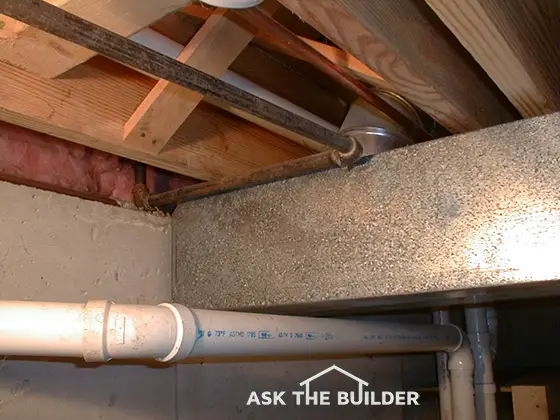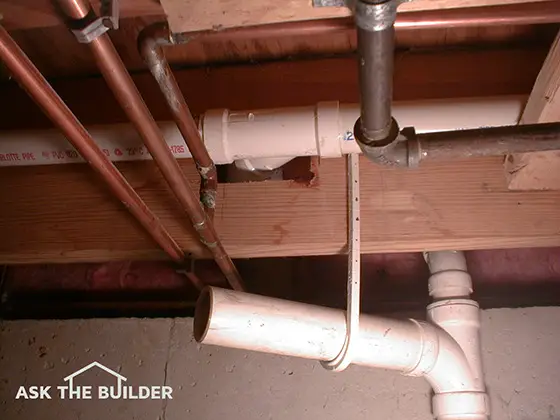Duct and PVC Pipe Noise

This ductwork and plastic plumbing piping can be the cause of all sorts of noises. © 2017 Tim Carter
Duct Noise TIPS
- Metal duct expands when heated
- PVC drain pipes expand with hot water flow
- Keep duct and PVC from touching wood
- Create 1/4-inch gap in pass-through holes
- CLICK HERE to Get Tim's FREE & FUNNY Newsletter!
DEAR TIM: Our new home is now three-years old. Ever since move-in day there have been annoying ticking noises in several interior walls of our home. Some of the noises start minutes after our furnace comes on.
The clicks then go away five minutes after the furnace shuts off. We also have cracking noises when someone takes a bath or shower in a second-floor bathroom. The builder says all of this is normal and nothing can be done.
We never had this problem before. What's going on and what can be done to stop these very annoying noises? Donna A. Columbus, OH
DEAR DONNA: You're a victim of simple expansion and contraction. The ticking, clicking and cracking noises are a by-product of metal ducting and pipes and plastic drain lines that are rubbing against the wood framing members of your home.
CLICK HERE to get FREE & FAST BIDS from local HVAC contractors who know about duct noise.
Heat Growth
These pipes and ducts grow in size as they're heated by the warm air and hot, or warm, water that passes through them. The expansion is a perfectly normal thing to happen, but the associated noise is not supposed to happen.
At first blush it appears your builder might be guilty of a half-truth. He could be telling the whole truth based on his reality because all his career he could have been building using practices that promote this bad behavior in building materials.
Just keep in mind that a half-truth is a whole lie.
Seasoned Subs
The reason your previous homes were noise-free could be many. Perhaps the plumbing drain lines were cast iron and experienced very little movement when hot water passed through them.
The heating system may have been different as well. The other possibility is that the heating and plumbing pipes in your old homes were made from the same materials as your new home and the tradespeople who installed them were more experienced.
These craftsmen knew how to insure the metal ducts and PVC drain pipes didn't rub up against any of the wood framing.
No Contact
Craftsmen who know that metal ducts and PVC plumbing lines move can do various things to make sure that movement happens with little or no noise. The trick is to isolate as much as possible the pipes from actually touching any wood framing.
For example, the large trunk heating duct is often suspended from the bottom of the floor joists one inch to make sure it does not touch the wood framing.
Expansion Collars
Expansion joint collars often separate the large trunk heating duct from the furnace's extended plenum metal. These collars absorb an enormous amount of the expansion and contraction that happens just above the furnace heat exchanger.
Without these collars, the movement and vibration happening in the furnace, or air handler, can be transferred to all the metal duct that extends through your home.
CLICK HERE to get FREE & FAST BIDS from local HVAC contractors who know about duct noise.
Larger Holes
The experienced heating and plumbing mechanics also know to create slightly enlarged holes for ducts and pipes to pass through. They also check to make sure a pipe can freely move as is passes through one or more studs or framing members.
If the pipe gets into a bind before it is heated and expands, it will most certainly snap, crackle and pop when it starts to grow from being heated.
PVC LOUD
PVC plumbing drain lines are notorious noise makers. Plastic has an enormous expansion contraction coefficient. The material grows in size dramatically and will crack and pop if it rubs against anything.
IMPORTANT TIP: If allowed to move freely, the PVC pipe will not make noise. This means plumbers must not allow the PVC pipe to touch any wood framing.
The PVC pipe noise is two-fold. Once the hot water stops flowing through the pipe, the PVC begins to cool and contract. It makes the same cracking noise as it shrinks back to its original size. Metal heating ducts suffer the same fate as they contract.

A large enough hole has been cut in this joist to insure the plastic pipe does not rub against the wood. © 2017 Tim Carter
Fixing the Noise
Exorcizing these demons from your walls isn't going to be easy. You'll need to isolate and identify the exact trouble areas.
Doing this almost always involves removal of the drywall or plaster. You can then often clearly hear and see the location where a pipe or duct might be rubbing against a wood framing member. The contact zone will need to be enlarged if possible so that an air gap exists for the pipe or duct to freely move.
Holes in Wood
Don't start to cut away wood or enlarge holes in joists or studs. There are strict limits to the notches and holes that can be made in framing members. The building code covers this in great detail with respect to the maximum size, shape and location of holes in wall studs, beams and joists.
Crack or Collapse
You can compromise the structural integrity of your home if you enlarge a hole too much. Never notch the bottom or top of a joist.
If in doubt, contact your local building inspector. Many inspection agencies will gladly advise you on what you can and can't cut. They don't want you or a family member to become a statistic.
Lubricants Evaporate
Don't count on lubricants to always solve the problem. They may be a short-term fix but over time the lubricant may dissipate. Permanent noise solution comes when you isolate the pipes and ducts from the wood framing.
Lumber Shrinks
Great builders and craftsmen also account for lumber shrinkage. The lumber used to frame the house can actually shrink over time.
Openings that were fine during the construction phase may become tight only six months later. There's no substitute for experience and brains when it comes to small detail items such as this.
CLICK HERE to get FREE & FAST BIDS from local HVAC contractors who know about duct noise.
Author's Note: I've received other questions about similar problems. Here's one from Greg in Toronto, Ontario.
"I just moved into a brand new 27-story condominium and when it gets cold outside I can hear loud bangs and cracking noises. Once when I heard the cracking sound, I also felt a vibration. Is this the concrete cracking."
Here's another one from Cheryll k. of Fenton, MO, regarding either the need for a water hammer arrestor or just noisy duct work.
"We heard an extremely loud "boom" last night at 4:00 a.m. I was already awake when it happened because my son had come in our room about 10 minutes prior to this because of a bad dream. He was still in our room and awake and heard the noise too. The noise woke my husband from a sound sleep.
Anyway, the noise sounded like dropping a dictionary from a second story down onto a hard floor. The weird part ... the sound appeared to come from right under our bed, right in our room. We got up, checked things and could not figure it out. We even checked our mattress and box springs. Is there any chance the noise could have been caused by something structural that happened between the second story floor and the ceiling below it? We don't see any outward signs of damage, but I am looking for an explanation for the noise. Thanks so much!"
Column 496
3 Responses to Duct and PVC Pipe Noise